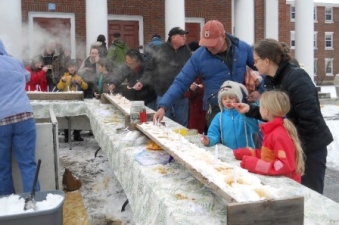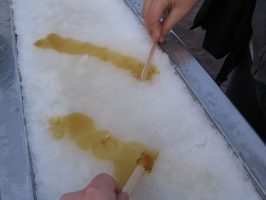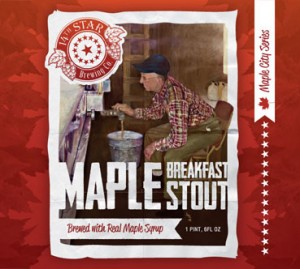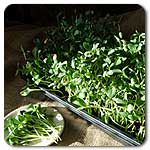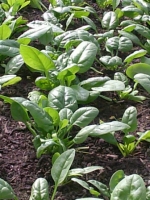This is an abridged version of an article that originally appeared in NOFA Notes, the quarterly newsletter of the Northeast Organic Farming Association of Vermont. For more information about NOFA Vermont and the benefits of organic, please visit www.nofavt.org
Butternut Mountain Farm
In the 1970s, David Marvin started Butternut Mountain Farm, a small sugaring operation on his family’s land in Johnson, Vermont. Over the last 40 years, what began as a very small sugaring operation has grown to encompass approximately 16,000 taps, and employ over 85 people – packaging and distributing syrup from at least 300 producers to a range of customers, including major retail and grocery chains and natural foods markets throughout the nation. This syrup, processed in the heart of Morrisville, is sold locally and online under the Butternut Mountain Farm label, bottled for numerous retailers’ private label brands, processed into maple sugar and candies, and sold to food producers who use it in products ranging from specialty cheese to vodka.
When Marvin began sugaring, Vermont produced an estimated 225,000 gallons of syrup per year, but efficiencies in production have allowed Vermont’s maple syrup industry to expand significantly; last year Vermont’s maple syrup production neared 1,300,000 gallons. That’s a quantity that even Vermont’s devoted maple-loving population can’t hope to consume locally, so much of the syrup is sold out-of-state through various markets: approximately 15% of the state’s production is sold directly through retail channels, and the remainder is sold either as bulk or wholesale. As an aggregator and distributor, Butternut Mountain Farm serves an important role that allows Vermont syrup from many family farms to reach larger markets.
Going Organic
In 2000, Marvin was approached by a customer – a large, national natural foods store – with a suggestion that he could expect a 30% increase in sales with certified organic syrup. So, Marvin applied for and gained organic certification for his sugaring operation. He and the store were both surprised when, instead of the predicted 30% sales increase, sales of organic syrup actually doubled.
Next, Marvin challenged himself to grow the sales of organic syrup in his other market channels. Now, 50% of the syrup sold by Butternut Mountain Farms is certified organic, and in addition to his own production, Marvin purchases organic syrup from at least 50 other certified organic maple syrup producers. The organic syrup’s sales continue to outpace its conventional counterpart.
Marvin initially resisted certification; feeling that the guidelines were common sense and that he didn’t want to deal with additional paperwork. He now recognizes the importance of organic certification, not just because of the sales it brings, but as a way to guarantee that he himself, and the sugar makers he works with, follow sound management practices.
Organic standards protect the organic integrity of syrup by requiring sugar makers to use non-synthetic defoamers (which are added to sap during boiling), clean equipment with food-grade sanitizers, and avoid galvanized buckets and storage tanks (which contain tin). In addition, organic syrup is periodically tested for potential contaminants.
More extensive are the requirements producers must follow to protect the long-term health and future growth of their sugarbush. These practices center around the creation of, and adherence to, a forest management plan that outlines strategies to promote and manage overall forest health, biodiversity, invasive species management and stand regeneration. In this way, the organic guidelines serve as a set of best management practices to ensure producers keep long-term forest health in mind.
Protecting the Organic Sugarbush
Organic standards have a lot to say about ensuring the long-term health of our maple forests. Organic producers are required to work with a forester to create and follow their forest management plan, and they also must submit to a yearly inspection where all of these processes are verified by an independent third party. Here are some key management practices required for organic maple production:
Logging practices:
Producers must log in a sustainable manner that minimizes impact.
Logging roads must not cause runoff, unnecessary compaction, or erosion issues.
Producers cannot use whole-tree harvesting to remove logs from a forest, the practice of which can significantly limit re-growth of future forests.
Tree selection:
To ensure growth of sizeable trees for a future maple crop, producers must wait until trees are at minimum 9” in diameter before tapping.
Producers must encourage biodiversity in their sugarbushes to increase nutrient recycling and to reduce the spread of insect and disease.
Tapping:
Tap holes must be distributed over as large an area of healthy wood as possible. This ensures that the tree will be able to continue normal sap flow and prevents the tree from damage and/or death.
Producers can only put a limited number of taps per tree.
Producers can’t use fungicidal treatments, which prevent tap holes from closing, invite disease and bacteria into the trees, and can stunt their future growth.
Sweet Success
Butternut Mountain Farm now has a waiting list of producers who want to sell syrup to them. As Vermont’s maple production continues to increase, Marvin will continue to seek new markets. Butternut Mountain Farm is doing essential work to build the infrastructure and sales channels that support many other farmers in Vermont’s diverse agricultural economy. Vermont is the nation’s leader in maple syrup production, and as long as climate conditions favor its production in this state, Butternut Mountain Farm will be a key driver supporting the strength of the sugaring industry for those involved.
Want more details on organic agricultural practices? Go to www.nofavt.org and browse their extensive resources!
Source: Dig in VT Trails


